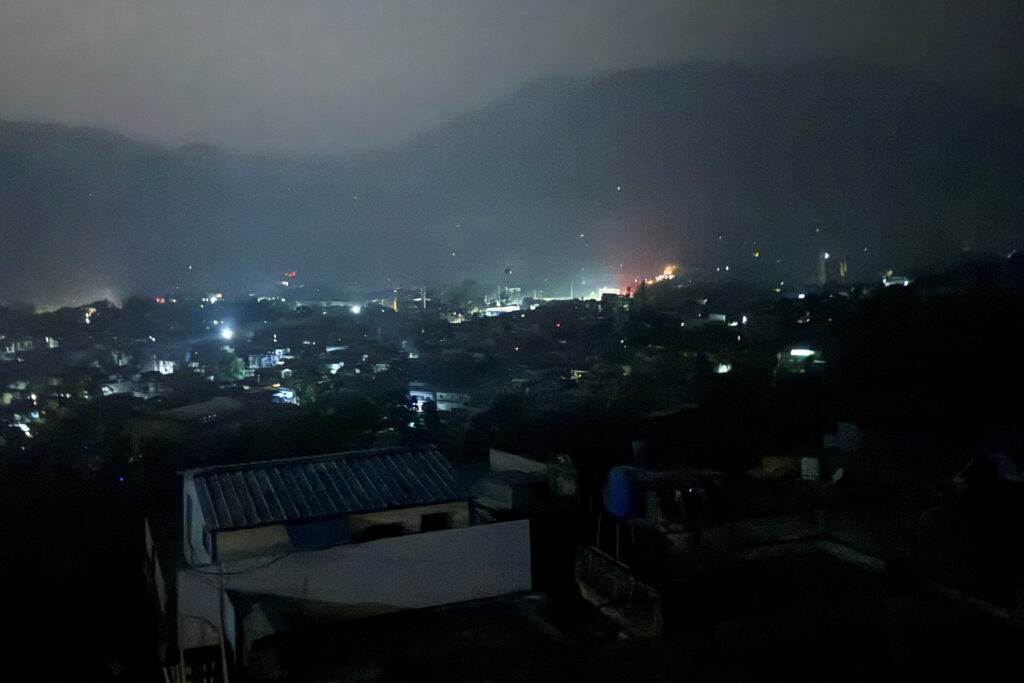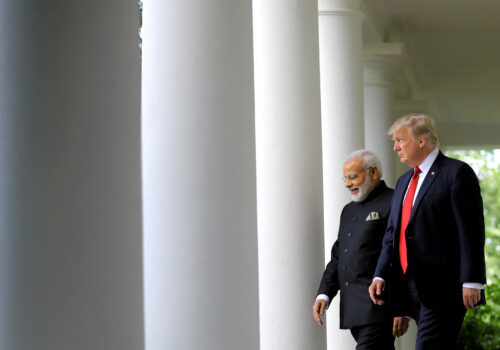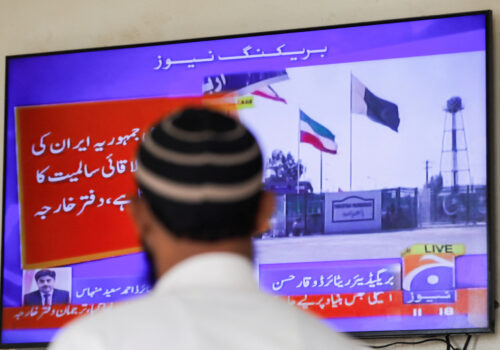Is this the end, or just the beginning? India conducted missile strikes against what it described as “terrorist infrastructure” in Pakistan and the Pakistan-administered parts of Kashmir in the early hours of Wednesday. The Indian government said the strikes were a response to a terrorist attack in Pahalgam in Indian-controlled Kashmir in April that killed twenty-six mostly Indian civilians, which the Indian government has blamed on the Pakistani government. The Indian operation, which hit at least five different locations, none of which were military sites, came amid concern that weeks of heightened tensions between the two nations could escalate into a war. Pakistan responded with artillery fire and claimed to have shot down a handful of Indian fighter jets. Where does this clash between nuclear-armed powers go from here? And how will the confrontation shape the two countries’ long-running dispute over Kashmir? We reached out to our experts for clarity in the fog of this emerging conflict.
Click to jump to an expert analysis:
Shuja Nawaz: Further escalation is possible in this combustible conflict
Michael Kugelman: The Gulf states are well placed to provide much-needed mediation
Manal Fatima: Ordinary Kashmiris continue to bear the brunt of these tensions
Atman Trivedi: The question is not if Pakistan will retaliate, but when and how
Alex Plitsas: Escalation appears unlikely after calibrated strikes
Rudabeh Shahid: India-Pakistan tensions will cause spillover problems across the region
These strikes follow a predictable pattern—and a water treaty could provide an off-ramp
This is not a surprise attack. In such military operations, predictability and patterns are important. India has upheld its reputation for reliability while preparing the world by briefing diplomats from Group of Twenty (G20) countries and others. The surgical 2016 strikes in response to the killing of nineteen Indian soldiers, the 2019 Balakot airstrike in response to the killing of forty Indian paramilitary personnel, and now Operation Sindoor, in response to a targeted, religiously motivated terrorist attack killing twenty-six men, follow a strategy that India has showcased since 2001. (In 2001, Operation Parakram, in response to terrorist attacks on the Indian parliament, lasted ten months in the form of a military standoff, the second since both countries tested nuclear weapons in 1998. It did not result in wider war.)
The Indian Defense Ministry’s statement immediately following the strikes assures non-escalatory intentions. Given this reliable history and a two-week diplomatic blitz following the terrorist attack, a further, immediate escalation or mobilization from India is unlikely.
The Pakistani leadership’s responses declaring that Indian actions constitute an act of war are also part of the pattern. Pakistan’s former foreign minister and its current defense minister have admitted to previous Pakistani involvement in funding extremist groups, and Pakistan must be transparent if it is to prove that it is not training terrorists or arming them with deadly military-grade weapons such as the AK-47s and M4 rifles used in the terrorist attacks.
India too ought to remain transparent and communicative with the global diplomatic community, while continuing its approach of counterterrorism. It should not take the bait of the terrorist attacks or of Pakistani leadership, and should instead play to its tactical, economic, and diplomatic advantages. In the long run, that will prove to be the most effective way to protect against further terrorist threats to the lives of Indian citizens and preserving Kashmir’s path to peace.
The United States, for its part, must push for transparency and dialogue. A key method of dialogue could be the renegotiation of the Indus Water Treaty, which was signed in 1960 and does not take into account modern climate and technological changes. Indian peacetime requests for renegotiations went unanswered. The treaty does not have an exit clause or renegotiation mechanism, and as such the parties need to be willing to converse. Water, instead of a source of tension, can be a source of conversation.
—Srujan Palkar is the global India fellow at the Atlantic Council.
Further escalation is possible in this combustible conflict
After deliberating and planning, India has attacked several sites inside Pakistan and in Pakistan-administered Kashmir (Azad Jammu and Kashmir), while claiming it chose to avoid military targets. Pakistan has a policy of “quid pro quo plus.” So expect a tougher response inside India and Indian-administered Kashmir, perhaps using standoff air-to-air weapons. Unlike in 2019, chances are that Pakistan may also target the launch or control centers responsible for the Indian missile attack. It has built up its electronic warfare capacity over the years.
The escalation ladder is steep. And, as in the past, captive local media and jingoistic politicians across the spectrum are baying for blood.
The world doesn’t need another flashpoint where both sides possess nuclear weapons, and standoff air and drone attacks could easily lead to the use of heavier weapons.
Sadly, the United States seems to have little clue about how to handle this situation. US Secretary of State Marco Rubio’s calls to leaders in both countries didn’t stop escalation. Is it time for China to play a positive role?
—Shuja Nawaz is a distinguished fellow at the Atlantic Council’s South Asia Center.
The Gulf states are well placed to provide much-needed mediation
India and Pakistan are experiencing their most serious crisis in several decades. The airstrikes that India carried out in Pakistan early Wednesday morning represented some of the most high-intensity and large-scale military activities that India has deployed there since 1971. A muscular Pakistani response is all but inevitable. Unlike the last two military crises between India and Pakistan, in 2016 and 2019, there is a strong likelihood of additional hostilities—and greater escalation risks—beyond an initial strike and counterstrike. This is no small matter given that India and Pakistan are both nuclear-armed states.
International mediation is of the essence to ensure the current confrontation doesn’t reach a point where nuclear escalation risks come into play. While there’s a strong international consensus in favor of de-escalation, few countries have the deep relationships and leverage to be effective mediators in this dangerous crisis. The United States has previously played the role of mediator, including during the 2019 India-Pakistan crisis under the first Trump administration. But the Arab Gulf states—especially Saudi Arabia, Qatar, and the United Arab Emirates (UAE)—may be best placed to intervene. They all have deep ties to both New Delhi and Islamabad. They’re also key suppliers of fuel and other assistance to Pakistan. And there is at least one precedent: In 2021, the UAE helped mediate an India-Pakistan border truce—an accord that kept bilateral ties relatively stable until the events of recent weeks.
Careful diplomacy from trusted interlocutors can help bring the two sides back from the brink. But given the scale of hostilities up to this point and the mood in each capital—and across the Indian and Pakistani publics—it won’t be easy.
—Michael Kugelman is a South Asia analyst and the writer of Foreign Policy’s South Asia Brief.
Ordinary Kashmiris continue to bear the brunt of these tensions
India’s airstrikes, launched amid Pakistan’s call for an evidence-based inquiry into the April 22 Pahalgam terrorist attack that killed twenty-six civilians, underscore the fragile and volatile dynamics of the region’s security environment. The response was anticipated, shaped by domestic pressure on the hyper-nationalist government in New Delhi and a long-standing precedent, including the 2019 Pulwama attack, which similarly escalated into cross-border hostilities. This cyclical exchange of strikes, rhetoric, and retaliations is not new. However, this very familiarity underscores a disappointing failure to learn from past mistakes.
In the immediate aftermath of the Pahalgam attacks, both governments reverted to entrenched narratives: India pointed to Pakistan’s record of harboring insurgent groups, and Pakistan alleged that the attack was a false-flag operation. This mutual blame game reflects a deeper strategic paralysis, an inability or unwillingness to address the root causes of the conflict.
At the center of this confrontation are the people of Kashmir. In recent days, Kashmiris have faced harassment and physical assaults in parts of Indian-administered Kashmir, reportedly targeted in retaliation for the Pahalgam attack. These incidents, compounding decades of political repression and securitized control in the region, highlight how ordinary Kashmiris continue to bear the brunt of both state and societal backlash amid renewed India-Pakistan tensions.
Strategically, a full-scale war serves neither side. Pakistan’s military strength would be offset by economic precarity, and military action would harm the country’s focus on attracting foreign investment. India, which is positioning itself as an emerging global economic power, cannot afford instability. In a nuclear neighborhood, the costs of escalation, whether accidental or intentional, are simply incalculable.
The United States has so far been very engaged on the issue in a neutral manner. Rubio has engaged both New Delhi and Islamabad in recent days, indicating that Washington would urge for de-escalation. “I just hope it ends very quickly,” US President Donald Trump said Tuesday evening in Washington. The administration should apply all possible pressure to make sure of it. Further, a broader diplomatic push that includes behind-the-scenes efforts by the United Kingdom, Saudi Arabia, and others with regional influence is essential. This brinkmanship endangers regional economic endeavors and threatens both countries’ security. Regional prosperity is dependent on sustained peace, which is not possible with the persistent specter of a confrontation between two nuclear-armed states.
—Manal Fatima is an assistant director at the Atlantic Council’s Scowcroft Middle East Security Initiative.
The question is not if Pakistan will retaliate, but when and how
The latest confrontation between India and Pakistan provides a stark reminder that the nuclear-armed nations have recently grown all-too-comfortable flexing their military muscle. India characterized its military strikes as measured and restrained. Nevertheless, the decision to target purported terrorist camps deep inside Pakistan, well beyond the disputed Kashmir region, will likely be interpreted by Pakistan’s generals as a significant escalation.
The question now is not whether Pakistan will respond, but when and how. Earlier this week, Pakistani Ambassador to Russia Muhammad Khalid Jamali threatened to use the country’s “full spectrum of power” in reply to an Indian military strike. Pakistan’s “quid pro quo plus” defense strategy is intended to inflict greater damage in retaliation than it first suffers, to deter Indian military action in the first instance. Pakistan’s powerful chief of army staff, Asim Munir, is a wild card, known to indulge in provocative rhetoric about Kashmir. He may prioritize ideological convictions over pragmatism. Meanwhile, China’s heightened involvement in and around South Asia, highlighted by its growing military and economic ties with Pakistan, introduces additional risks. The region finds itself at a moment where miscalculation, accidents, or plain bad luck could conspire to produce a major conflict.
In the past, the United States and other countries have used quiet diplomacy to help defuse regional crises. In the first Trump administration, for instance, senior US officials worked the phones to help de-escalate tensions in South Asia. Six years later, Washington and like-minded partners are distracted and inward-focused.
The dangerous mood on South Asia’s streets, fueled by jingoistic media outlets that border on hysteria, is hardly conducive to disciplined and careful crisis management. Cooler heads may yet prevail, but not before the region edges closer to war.
—Atman Trivedi is a nonresident senior fellow at the Atlantic Council’s South Asia Center and a partner at Albright Stonebridge Group.
Escalation appears unlikely after calibrated strikes
India’s “Operation Sindoor” is a limited counterterrorism operation targeting nine terrorist camps in Pakistan and Pakistan-administered Kashmir. The strikes were a direct response to the April 22, 2025, Pahalgam attack in Indian-administered Kashmir, where militants from the Resistance Front (TRF), allegedly linked to Pakistan-based Lashkar-e-Taiba, killed twenty-six civilians, mostly Indian tourists. India’s Ministry of Defense described the operation as “focused, measured, and non-escalatory,” emphasizing that it struck only terrorist infrastructure, such as training camps in Muzaffarabad and Kotli, and avoided Pakistani military or government facilities. However, Pakistan denied that the strikes hit terrorist targets, claiming that they hit civilian areas. Indian forces used precision missiles, and aircraft did not cross into Pakistani airspace, signaling restraint meant to prevent broader conflict.
India’s actions aimed to neutralize immediate threats while minimizing the risk of escalation. By publicly framing the strikes as counterterrorism-focused and avoiding sovereign Pakistani targets, New Delhi sought to limit retaliatory pressure on Islamabad. Pakistan condemned the strikes, alleging civilian casualties. In response, there have been reports of clashes along the line of control with artillery and small arms fire being exchanged by both sides with unconfirmed reports of limited civilian casualties. The operation’s design mirrors India’s 2016 and 2019 strikes, which targeted militants without triggering full-scale war, suggesting a pattern of calibrated responses.
Despite heightened tensions, including prior diplomatic and economic measures like trade suspensions and airspace closures, escalation appears unlikely. Both nations, aware of their nuclear capabilities and under international pressure from the United States and United Nations, have incentives to avoid war. Diplomatic channels, including back-channel communications, remain open, and historical precedents show both sides can de-escalate after limited actions. While the situation in Kashmir remains volatile, India’s restrained approach and Pakistan’s cautious rhetoric suggest a mutual interest in containing the crisis.
—Alex Plitsas is a nonresident senior fellow with the Scowcroft Middle East Security Initiative, the head of the Atlantic Council’s Counterterrorism Project, and a former chief of sensitive activities for special operations and combating terrorism in the Office of the Secretary of Defense.
India-Pakistan tensions will cause spillover problems across the region
As non-nuclear members of the South Asia Association of Regional Cooperation (SAARC) surrounding India, countries such as Bangladesh, Sri Lanka, Nepal, Bhutan, and the Maldives would find themselves increasingly constrained in a scenario of India-Pakistan escalation over Kashmir—a development that would further entrench the paralysis of regional cooperation under SAARC.
If tensions between the two nuclear-armed neighbors escalate, the geopolitical and domestic consequences for these smaller South Asian states will be complex. Most exposed is Bangladesh, where the recent regime change has removed Sheikh Hasina’s pro-India administration and installed an interim government navigating a deeply polarized landscape. Anti-India sentiment is running high, fueled by perceptions of Indian interference and growing frustration at India for hosting the former Bangladeshi prime minister. The interim leadership, lacking a political mandate, will face acute pressure from sections of civil society to adopt a more assertively nationalist, possibly anti-India, stance. At the same time, India is likely to increase expectations of diplomatic alignment, leaving Dhaka in a highly precarious position.
In Sri Lanka, the government is likely to maintain a cautious neutrality while quietly accommodating India’s regional security posture. However, an intensification of the Kashmir conflict could create unrest within Sri Lanka’s Muslim communities, particularly if the issue is framed as part of a broader crackdown on Muslim populations. These internal dynamics could destabilize a government already managing economic fragility.
Nepal would attempt to preserve its balancing act between India and China, but India may view Nepal’s neutrality with suspicion. Recent bilateral tensions, including territorial disputes and Kathmandu’s assertion of greater sovereignty, make it vulnerable to diplomatic pressure. Nepal’s large labor force in India also adds an element of economic dependency that could be leveraged.
Bhutan is most likely to align quietly with India, given its close strategic ties, but any Indian military distraction could embolden Chinese activity along the contested northern border.
The Maldives, meanwhile, will face rising Islamist sentiment at home if Kashmir becomes a rallying point. At the strategic level, increased Indian Ocean militarization will reduce space for Malé’s hedging strategy.
Overall, a Kashmir flashpoint would harden regional alignments, reduce strategic autonomy, and raise the domestic political costs of neutrality for South Asian non-nuclear states.
This, in turn, would have implications for US Indo-Pacific strategy. Washington views India as a cornerstone of its regional balancing efforts against China, particularly through platforms such as the Quad. A protracted India-Pakistan crisis would not only divert India’s strategic focus away from the maritime Indo-Pacific and toward its western land borders, but also constrain its ability to act as a net security provider in the region.
—Rudabeh Shahid is a nonresident senior fellow at the Atlantic Council’s South Asia Center.
Further reading
Mon, Feb 10, 2025
The continent-spanning win Trump can secure with Modi
New Atlanticist By William F. Wechsler
When the Indian prime minister visits the White House this week, high on the agenda should be the India-Middle East-Europe Economic Corridor (IMEC).
Tue, Mar 25, 2025
Starlink’s India launch is a crash course on New Delhi’s approach to tech sovereignty
New Atlanticist By Trisha Ray
A recently announced partnership to deploy the Elon Musk-led company’s satellite internet in India offers a window into New Delhi’s “hybrid” approach.
Thu, Jan 25, 2024
The skies are quiet, but the Iran-Pakistan strikes left lasting diplomatic damage
New Atlanticist By
While the immediate crisis will subside, an intensified security dilemma will be permanent for Islamabad.
Image: A city view of Muzaffarabad in Pakistan-administrated Kashmir, May 7, 2025. REUTERS/Stringer.




